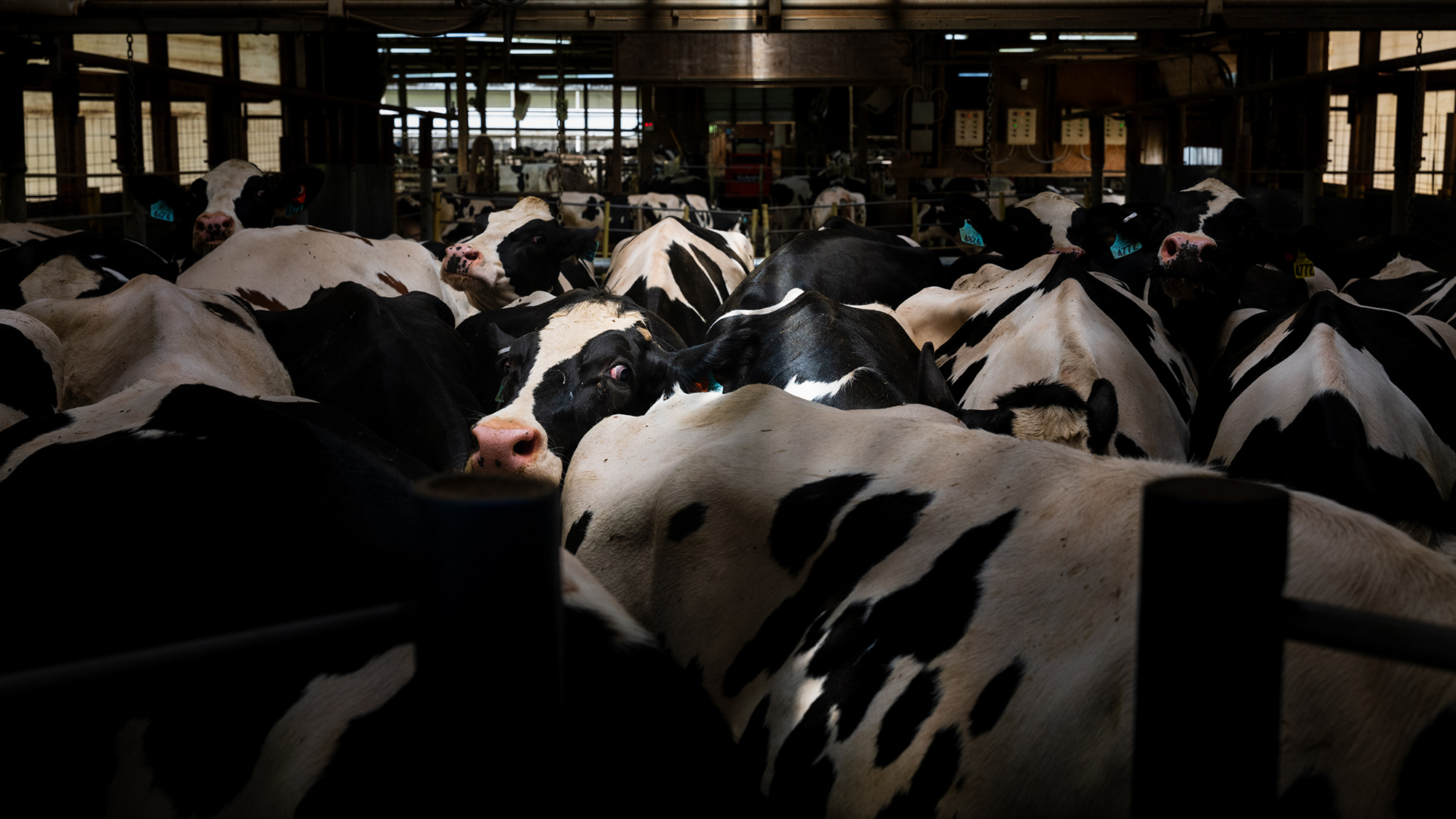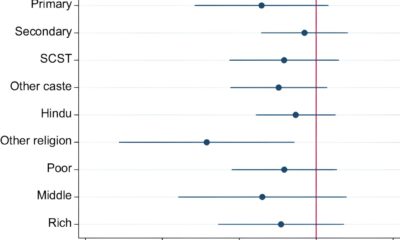Technology
Can we prevent a bird flu pandemic in humans?

A highly pathogenic subtype of avian influenza (or bird flu), known as H5N1 is spreading among animals worldwide. For the past couple of decades, global health agencies have kept tabs on the virus, which is most well known for decimating poultry flocks and infecting wild birds, while mammalian and human cases have been rare.
Yet the current spate of outbreaks, first detected in Europe in Fall 2020, has drawn particular concern and attention. Unlike in prior outbreaks, mammalian infections have become significantly more common, and many mammal species including pet cats, seals, foxes, mice, skunks, bobcats, and even a bottlenose dolphin have been falling ill and testing positive for the flu. Also unlike in past outbreaks, some mammals seem to be spreading the virus among themselves, indicating that H5N1 has mutated to be more easily transmissible beyond birds.
In one of the latest developments, dairy cows in the U.S. have begun contracting the influenza subtype, shedding it in their milk. An outbreak first detected in Texas in March has now impacted at least 12 states, with cases so far reported on 90 dairy farms nationwide– numbers many experts believe to be an underestimate.
“Avian influenza is something that most people in epidemiology, infectious disease, and pandemic preparedness have been worried about for a long time,” says Nahid Bhadelia an infectious disease physician and the founding director of Boston University’s Center on Emerging Infectious Disease. “What’s different about the current scenario is that you are seeing possible changes in the way that the virus is now infecting animals, to the point where it’s closer to where human beings are–both geographically and physiologically,” she tells Popular Science.
Livestock and humans exist in close proximity, particularly in the case of dairy cows, which have to be regularly milked by dairy workers. With more human-animal contact opportunities, the virus, which has already spilled over from wild birds into dozens of species around the world, could continue to mutate and eventually become readily transmissible between people, Bhadelia says. Sustained human transmission would be a step towards a bird flu pandemic that hasn’t been observed before.
“Avian influenza is something that most people in epidemiology, infectious disease, and pandemic preparedness have been worried about for a long time.”
Since 1997, 912 human cases of H5N1 have been confirmed globally, according to the Centers for Disease Control and Prevention. The large majority of these infections were in people with close contact to infected animals. A small portion of cases are believed to be attributable to human-to-human transmission, but sustained human-to-human transmission hasn’t been seen.
In the current outbreak, three human cases of H5N1 have been reported in the U.S., all mild infections in dairy workers. To mitigate the risk of many more human cases, experts say we need proactive efforts involving virus surveillance, multiple types of testing and data collection, robust communication and information sharing, new biosecurity strategies, worker safety protections, and improved vaccines.
Knowledge is power
Ultimately, we can’t control how a virus’ genome changes, and we can’t entirely avoid the possibility of another flu pandemic, says William Schaffner, a physician and infectious disease professor at Vanderbilt University. What we can do is try to reduce risk and control how we prepare for it. Testing, multiple sources say, is a big part of that.
“Everyone agrees, I think, that we would love to do much more testing than we’re doing at the present time,” Vanderbilt says.
“There should be more testing,” in more states, of more animals, of more people, and of environmental proxies for viral spread like wastewater, says Bhadelia.
“Where I really think we should be focused is testing of farmworkers and testing of animals,” Celine Gounder, an infectious disease specialist and epidemiologist at New York University and the Kaiser Family Foundation, tells Popular Science.
“Everyone agrees, I think, that we would love to do much more testing than we’re doing at the present time.”
“We don’t have what we need to be making effective decisions. The number one priority I would identify is we need to be doing a lot more surveillance,” says Rachael Piltch-Loeb, an assistant professor of public health and policy at the City University of New York.
Though testing alone doesn’t stop viral spread, it provides key information about where and how that spread is happening. “Not knowing is never a good thing,” emphasizes Shaffner. Currently, there are lots of unanswered questions about H5N1 in cows and people. We don’t know how often exposed animals or people become infected, we don’t know everywhere the virus is currently spreading, we don’t know if it is moving through airborne transmission or just contact with contaminated equipment and milk droplets.
In past human cases, the fatality rate for H5N1 has been about 50%. But none of the three recently infected U.S. workers have died or even gotten severely ill. Why is “one of the great mysteries,” Bhadelia says, though she adds that that historical fatality rate is likely a big overestimate. Often only the most severe infections are documented early in a virus’ emergence and multiple factors like differences in transmission route, viral mutations, and who is getting sick and where can drastically shift disease outcomes. But still, we need testing to know more.
“Not knowing is never a good thing.”
Testing doesn’t just show what animals or people are currently positive for the virus, but it can also reveal how spread is unfolding, by what means, and specifics about the virus itself. Understanding the geography of outbreaks can inform when and where isolation strategies like quarantines are applied. With testing and follow-up, close contacts of infected people and animals can be monitored and precautions can be taken to minimize spread. Genetic sequencing performed on virus samples collected through tests can help virologists spot new, potentially dangerous mutations and piece together paths of transmission. Serology testing, which measures antibodies in blood, can show if there are asymptomatic cases proliferating in people and animals.
“The notion of surveillance is to identify a problem before it is at the scale that we can’t control,” says Piltch-Loeb. With the problem identified, you can offer clearer guidance.
There are many testing efforts already underway. The USDA has begun mandating testing for lactating dairy cows being transported across state lines. The CDC is continuing to track influenza A cases beyond the regular flu season. And multiple state agencies have voluntary testing programs. Yet these efforts haven’t been as successfully implemented everywhere and there are barriers in trust and communication standing in the way.
Collaboration is key
Pandemic prevention needs to be a collaborative effort between government agencies at every level and the stakeholders most directly affected by the spreading virus, says Bhadelia. In most places, dairy farm owners and workers have been slow to start testing for and reporting cases.
Unlike poultry and pig farmers, dairy farmers haven’t previously been swept up in an avian influenza scare. Suddenly, their livelihood is potentially at risk. “They’re all confused and anxious about this,” says Schaffner. Owners don’t want to test cows and then be forced to shut down milk production and lose money.

At the same time, many farm workers–often undocumented and economically vulnerable– are reluctant to report symptoms or undergo testing because they want to avoid government attention and deportation, Gounder notes. Both groups need assurances and incentives to get them on board in the public health effort, she says. In May, the USDA announced a compensation program to help dairy farmers bear the costs of testing their livestock, sampling their milk, sanitizing equipment, and the burden of lost milk production. Ideally, Gounder says there would be a similar federal effort to protect workers–potentially granting them legal status– if they come forward for testing as well.
Figuring out how to boost trust and dialogue with farms is an ongoing process nationwide, but one place is already ahead of the curve. Michigan has been a standout, say both Piltch-Loeb and Bhadelia. Michigan is doing more testing and reporting than any other state (hence why they’ve detected more cases among both cows and humans than anywhere else–it’s not because there’s actually more virus there, says Bhadelia).
“The number one priority I would identify is we need to be doing a lot more surveillance.”
Natasha Bagdasarian, the state’s chief medical executive and an infectious disease physician, credits much of that success so far to transparent communication and a dedication to building proactive and inclusive public health infrastructure. They’ve expanded their testing lab capacity to seven-day-a-week operations. They’ve got locally known dairy inspectors reaching out to farmers they’ve already established relationships with. They’ve been coordinating across human health, natural resource, labor, veterinary, and agricultural departments with daily meetings. They’re working with local health providers and migrant worker outreach organizations. “From day one, we’ve taken a very ‘one health’ response to this–it’s the concept that human health, animal health, and environmental health are closely linked.”
In Michigan, as with everywhere else, trust in public health entities declined during the Covid-19 pandemic, says Bagdasarian. But the state took that decline seriously and began trying to combat it even before avian influenza materialized in midwest dairy farms, she notes. The state created a public health advisory council that published a report full of recommendations last year. “Maybe some of that work is paying off,” she says.
“It doesn’t make sense for us to put out guidance that isn’t practical for people on the ground.”
The state has a serology study planned. Michigan dairy workers receive regular health check-ins via text. The state agricultural agency has required farms to implement biosecurity measures like disinfection of people and vehicles moving between farms and logging farm visitors. Health officials there are also talking with dairy workers to better understand the riskiest aspects of their job and what sorts of personal protective equipment might be best to recommend–PPE should ideally grant safety without compromising someones’ ability to work. “It doesn’t make sense for us to put out guidance that isn’t practical for people on the ground,” says Bagdasarian. It’s just one of many ways engaging those on the front lines is important.
Improving vaccines
Testing, PPE, incentives, and information sharing are all important public health measures. But ultimately, the only thing that can stop a virus in its tracks–especially one that is widely circulating in wild animals– is an effective vaccine, says Michael Osterholm, an epidemiologist and director of the Center for Infectious Disease Research and Policy at the University of Minnesota.
“We need much better vaccines– ones with durability, broad range of prediction, and that are readily available,” he says. Continually studying flu viruses and funding vaccination development is critical, he adds.
The Administration for Strategic Preparedness and Response, part of the federal Department of Health and Human Services, does have a candidate vaccine for H5N1 that’s being stored in bulk. The administration announced plans in May to put that vaccine into vials, producing nearly five million doses over the next few months. This is a good step towards preparedness, says Bhadelia, but it comes with complications.
People have to be convinced to take a vaccine.
Once portioned into vials, vaccine doses begin the countdown to expiration, says Schaffner. Vaccines can interfere with our ability to track flu spread, because vaccinated people will have antibodies, despite no history of actual infection, notes Bhadelia. People have to be convinced to take a vaccine. How, where, and when to deploy those doses remains unsettled. And it’s unclear how well the candidate vaccine will protect the possible future strains of virus that might mutate to transmit between people, says Osterholm.
Conversations about if and how to use vaccines are ongoing in Michigan, says Bagdasarian, and beyond, says Schaffner. Soon, there will be a national case study to look to in Finland. There, the disease hasn’t yet appeared in cows, but there have been outbreaks on poultry, mink, and fox farms. The government will soon offer H5N1 vaccines to select groups of people with potential exposure routes like scientists studying the virus, certain farmers, and veterinarians. That test could help improve future vaccination formulas and strategies.
Flexibility and understanding
There is no biological law that says H5N1 will definitely become a pandemic disease that easily passes from person to person. A pivotal mutation emerging would be the product of randomness and opportunity–likely beginning with an unlucky animal or person getting infected with two flu types at once, allowing the viruses to “reassociate” and swap genetic material. At multiple points over the past 25 years, Osterholm says flu scientists have warned of an imminent potential avian flu pandemic. In 2012, he notes that biologists said the virus was just one mutation away from that worst-case scenario. So far, that threat hasn’t materialized. But there is also no biological law that says it won’t. Flu pandemics have occurred throughout human history, and as recently as 2009 with swine flu (H1N1). A future flu pandemic–whether it be from this particular global outbreak or another–could always happen, Osterholm says–which is why preparedness and thinking ahead are so important.
The CDC maintains that the threat of avian flu to the general public is low for the time being. Dairy workers are currently the people most at risk. But there are still some steps that everyone can take towards public health right now. For starters, people should take extra care in interacting with animals–wild or domestic, says Bhadelia–especially those that seem sick. And everyone should absolutely avoid drinking raw unpasteurized milk, say Bhadelia and Schaffner.
There is no biological law that says H5N1 will definitely become a pandemic disease that easily passes from person to person… There is also no biological law that says it won’t.
Unpasteurized milk is always a safety risk, but especially so now–when we know that at least one in five milk samples contain H5N1 virus. Cats and mice have gotten sick and died of the avian flu after drinking milk from infected cows. The virus ended up in the cats’ brains and lungs, triggering lesions. And it’s not just a matter of individual safety. When it comes to opportunities for H5N1 to evolve in humans, every person who decides to drink raw milk is opting to potentially trigger a public health crisis. Little is clear and well-established about H5N1 right now, but over 100 years of scientific evidence supports pasteurization of milk for human health and safety.
Beyond the immediate, an open mind will be important moving forward. Given the number of unknowns, one of the most critical aspects to a successful pandemic risk mitigation effort is flexibility, says Schaffner. “We’re going to learn a lot of new things, we may have to change our minds. That’s a very hard thing for the public to grasp.” Yet still, people will have to keep up. Communication and education efforts will have to improve. Health agencies at every level will have to share information as they learn it. The public will have to have reason to trust that information, even as it shifts.













